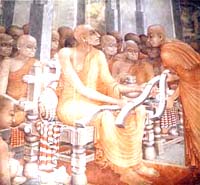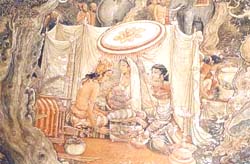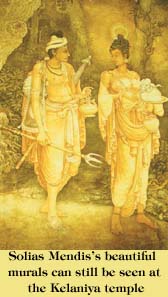 |
 10th May 1998 |
Front Page| |
Mural magicBy Upali Salgado
It was a communication gap that separated the two, because Solias Mendis knew no English nor Italian. He spoke only an age old Aryan dialect Sinhala. Dr. Marianze was amazed at the simplicity the maestro displayed, but he knew they both had one thing in common - Temple Murals. And talking of Temple Murals, undoubtedly Solias Mendis was acknowledged to be in modern times the “Painter of Painters, the maestro incomparable.” It is said that, he was a genius inspired by the Hindu Goddess Saraswathie, the venerated icon of Art.
At the Sumera Kusumaramaya Temple, Nattandiya, the young lad’s imagination ran riot, when he painted (still to be seen) alongside Gotama Buddha, a large Railway locomotive, steaming away with a train of coaches or carriages. Perhaps, in accordance with his imagination, it was a journey to Nirvana (the bliss of heaven). The Railway was unknown during the Buddha’s time! Obviously, the boy was fascinated with the Railway system - the “Yakada Yaka” (“the iron devil”) as it was first known to the unsophisticated Ceylonese villager. When Solias Mendis was a little older, he worked as a junior artist under his Uncle Monis Silva, himself a “Master” in the field of that time.
He began his work, determined to abandon the vivid shades that had been in vogue, used by M. Sarlis. He introduced to Kelaniya the style of Ravi Varma, which is associated with the Bengali renaissance of art, and much attention was given to detail of facial expression. Even the wrinkles seen on the forehead made the faces look real.
When painting, the Architecture of buildings, costumes and furniture, appear to be authentic and indigenous. He stood on scaffoldings for nineteen long years to paint all that we see, but one day he left the Kelaniya Temple never to return there, a heart broken man without completing the painting in the main Buduge. The Gods had decreed that it had to be so, and differences of opinion were aired. It was left to the Russian born, Karl Kassman to complete the paintings in the Centre room with a backdrop of the Himalayas, to give an impression that the Buddha was looking down with compassion, on humanity from a great height. Having lived in a Buddhist temple atmosphere, Solias knew of the teachings of the Great Blessed One, the Master of all, and when in the evening of his life, he was inspired by the Sivi Jataka. With such a stimulation, he donated to Dr. G.P. Malalasekera, President of the All Ceylon Buddhist Congress, all his meagre savings and two acres of land with the request that the ACBC build and maintain a Home for the Blind at Ihala Mahawewa. A question often posed is why did he want to set up a Home for the Blind? The Buddhist Jataka story states that the Buddha as a Bodhisatva, took the form of a blind beggar and appeared before King Siviraja, who then with great joy, plucked off his eyes and donated them to the blind beggar. Solias Mendis knew that his own beautiful paintings at Kelaniya, would never be enjoyed by the blind. So to make amends he gave to the blind all the wealth that he possessed. The Siviraja Home for the Blind was founded and what greater joy would he have had than on that occasion. The saga of this simple villager ended on September 1, 1975, uncelebrated as he was. He received no National Honours, no funeral orations. At his simple funeral, there were the muzzled drums and a Pansakula, with a vast gathering of Buddhists of the area in attendance. Ceylon had lost in him a national treasure. (Vesak Lipi) |
||
 |
Front Page| News/Comment| Editorial/Opinion| Business| Sports | Mirror Magazine |
|
 |
Please send your comments and suggestions on this web site to |
|
 He
looked a simple villager from Madampe, like just another Appuhamy or Heen
Banda with traditional hair knot (Konde). When Dr. Marianze, the world
famous Art Conservator sent to Ceylon by UNESCO (to help preserve the Sigiri
Frescoes that had been damaged by vandals in 1968) was introduced to Walimuni
Solias Mendis by Dr. Raja de Silva, (our one time Archaeological Commissioner)
Mendis and Dr. Marianze just gazed at each other in wonderment. There was
stoic silence and the two, the simple villager and the world renowned Art
Conservator smiled. No doubt that moment recorded a rare greeting.
He
looked a simple villager from Madampe, like just another Appuhamy or Heen
Banda with traditional hair knot (Konde). When Dr. Marianze, the world
famous Art Conservator sent to Ceylon by UNESCO (to help preserve the Sigiri
Frescoes that had been damaged by vandals in 1968) was introduced to Walimuni
Solias Mendis by Dr. Raja de Silva, (our one time Archaeological Commissioner)
Mendis and Dr. Marianze just gazed at each other in wonderment. There was
stoic silence and the two, the simple villager and the world renowned Art
Conservator smiled. No doubt that moment recorded a rare greeting.  When
the Venerable Madampe Sugatissa Maha Thera of the Wherahena Temple, Nattandiya
took under his devoted care his nephew Solias Mendis, little did he realize
that the playful lad, who displayed no keenness to learn the age old Pali
language and Buddhist suttas to be considered fit for Ordination as a Buddhist
monk, would some day be a renowned master of mural painting. At the age
of fourteen he showed extraordinary prowess as an artist. His liking for
the subject made him abandon his parents’ desire that he be ordained a
Bhikku (Buddhist monk).
When
the Venerable Madampe Sugatissa Maha Thera of the Wherahena Temple, Nattandiya
took under his devoted care his nephew Solias Mendis, little did he realize
that the playful lad, who displayed no keenness to learn the age old Pali
language and Buddhist suttas to be considered fit for Ordination as a Buddhist
monk, would some day be a renowned master of mural painting. At the age
of fourteen he showed extraordinary prowess as an artist. His liking for
the subject made him abandon his parents’ desire that he be ordained a
Bhikku (Buddhist monk).  At
the time a new Viharage was being built at the Kelaniya Raja Maha Vihara.
The great benefactress who was herself a devout Buddhist, Helena Wijewardene
of the Sedawatte Walauwe, sought the assistance of Solias Mendis who had
earned a name as a talented artist of untainted character, to execute the
required wall paintings.
At
the time a new Viharage was being built at the Kelaniya Raja Maha Vihara.
The great benefactress who was herself a devout Buddhist, Helena Wijewardene
of the Sedawatte Walauwe, sought the assistance of Solias Mendis who had
earned a name as a talented artist of untainted character, to execute the
required wall paintings.  These
inspired creations were clothed in a mixture of soft shades, giving flashes
of a little orange with a tinge of lemon and red where necessary, to provide
life and contrast as well. The paint he made himself from boiling an unorthodox
concoction of herbs and roots and bark of trees found in certain parts
of the island, had for its base a white clay, often moistened. He also
added certain unknown ingredients to act as preservatives of colour.
These
inspired creations were clothed in a mixture of soft shades, giving flashes
of a little orange with a tinge of lemon and red where necessary, to provide
life and contrast as well. The paint he made himself from boiling an unorthodox
concoction of herbs and roots and bark of trees found in certain parts
of the island, had for its base a white clay, often moistened. He also
added certain unknown ingredients to act as preservatives of colour.